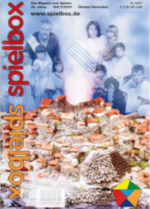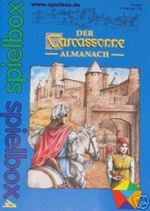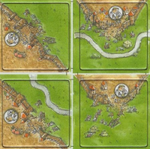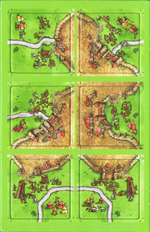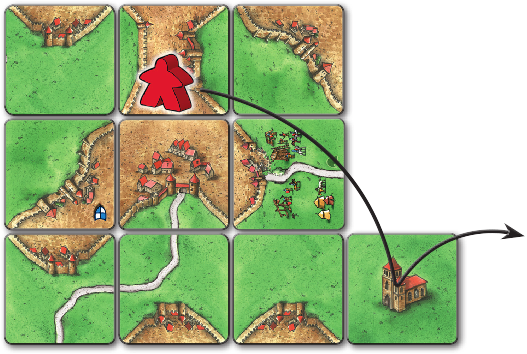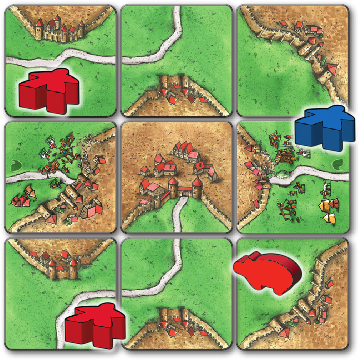Asediatorii / Catarii / Asediu (prima ediție)
Informații generale și comentarii
The Cathars (Die Katharer) was originally released in Spielbox in 2004 and republished in Carcassonne Almanach in 2005.
Siege (part of Cult, Siege, & Creativity) was originally released by Rio Grande Games in 2008.
The Besiegers (Die Belagerer) was originally released by Hans im Glück in 2013.
During the 11th and 12th centuries, a new religion called Catharism developed in southern France. The Roman Church decreed that this religion was heretical. By the beginning of the 13th century Carcassonne had become a stronghold of the Cathar religion. After unheeded warnings and the murder of a church legate, Pope Innocent III initiated a crusade against the Cathars. The besieging of Carcassonne in 1209 marked the start of 40 years of continuous war.
The Cathars expansion of 4 tiles was initially released in Spielbox in 2004, and because of its rarity, it has become one of the most sought-after Carcassonne expansions. Copyright prevented The Cathars from being reprinted by anyone except Spielbox, so Rio Grande Games developed Siege to be able to publish tiles with the same function. The four tiles in Siege have the same functional layout as the tiles in The Cathars, but the artwork is entirely new. Thus, Siege is effectively a reprint of The Cathars with updated artwork. The rules for Siege are also almost identical to those for The Cathars; the only difference involves escape from a besieged city (see rules below).
Ultimately, Hans im Glück recognized the popularity of The Cathars and published The Besiegers in 2013 to allow players to be able to obtain this element of Carcassonne again. The rules are identical to those of The Cathars, but the geography of the Besiegers tiles and the tile artwork are all new. Interestingly, the 2014 version of the Besiegers rules includes the note: “This mini-expansion appears in the 2004 Spielbox magazine under the name 'The Cathars’ (with only 4 tiles).” This seems to indicate that this expansion is considered a reprint rather than a new expansion, even though the tile features are different between the two sets.
Conținut
- Catarii: 4 cartonașe de teren noi
- Asediu: 4 cartonașe de teren noi
- Asediatorii: 6 cartonașe de teren noi
Reguli
Atașarea unui cartonaș
Noile cartonașe de teren trebuie amestecate împreună cu celelalte cartonașe de teren. În afara următoarelor reguli, toate regulile jocului Carcassonne rămân aceleași.
Evaluarea drumurilor, orașelor și mănăstirilor finalizate
Un oraș finalizat
Orașele care conțin cartonașe din Asediatorii / Catarii / Asediu sunt numite drept asediate.[1] De fiecare dată când un oraș asediat este finalizat în timpul cursului jocului, fiecare cartonaș și fiecare blazon[2] din acel oraș valorează doar câte 1 punct în loc de 2. Dacă orașul conține o catedrală, atunci valorează doar câte 2 puncte pentru fiecare cartonaș și blazon (în loc de 3).
Evadarea dintr-un oraș asediat (Zbor)
It is possible to escape a besieged city via a neighboring cloister. [3] [4] If a cloister directly borders a Besiegers or Cathars tile, [5] even diagonally, then at the end of a player's turn[6], he or she may remove one knight [7] [8] from the besieged city and return it to the supply. [9] [10]
Sfârșitul jocului
Evaluarea orașelor
Should the city remain incomplete at the end of the game, it scores no points during the final scoring. It follows the "-1 point per tile and pennant" rule.
Evaluarea câmpurilor
The farmers supply provisions to both the besiegers and the besieged. As such, every farm scores double points for each completed besieged city on that farm – 6 points for a normal farm, or 8 points for a farm with a pig.[11] Multiple sieges of a city have no further effect.[12]
Referință pentru cartonașe
Asediatorii
Catarii
Asediu
Note de subsol
Pentru licențierea și semnificația pictogramelor te rugăm să vizitezi Pagina pictogramelor.
- ↑
 Ia în vedere că numărul de cartonașe din Asediatorii / Catarii / Asediu din oraș nu contează. Toate cartonașele asediate sunt tratate în același fel în legătură cu evaluarea, indiferent de numărul de cartonașe asediatoare. (12/2014)
Ia în vedere că numărul de cartonașe din Asediatorii / Catarii / Asediu din oraș nu contează. Toate cartonașele asediate sunt tratate în același fel în legătură cu evaluarea, indiferent de numărul de cartonașe asediatoare. (12/2014)
- ↑
 Blazoanele nu fuseseră menționate în regulile inițiale pentru Catarii sau Asediu, dar au fost incluse într-o clarificare ulterioară.
Blazoanele nu fuseseră menționate în regulile inițiale pentru Catarii sau Asediu, dar au fost incluse într-o clarificare ulterioară.
- ↑
 A knight in a besieged city can also escape via an abbey or a shrine, as these also have the characteristics of a cloister.
A knight in a besieged city can also escape via an abbey or a shrine, as these also have the characteristics of a cloister.
- ↑
 Mayors and wagons can also escape a besieged city via cloisters, abbeys, and shrines, as any follower in a city is considered a knight.
Mayors and wagons can also escape a besieged city via cloisters, abbeys, and shrines, as any follower in a city is considered a knight.
- ↑
 Note that in The Besiegers and The Cathars, a cloister must be placed directly adjacent to a Besieger/Cathars tile to allow a knight to escape. However, RGG's rules for Siege state that a cloister allowing escape can be placed adjacent to any tile of a besieged city (even diagonally). For the sake of consistency, at the beginning of the game it would be useful to select only one of these rules when combining tiles from these sets. Purists can choose the Besiegers/Cathars rule, as it’s the German original, although the RGG Siege rule makes escape much more viable.
Note that in The Besiegers and The Cathars, a cloister must be placed directly adjacent to a Besieger/Cathars tile to allow a knight to escape. However, RGG's rules for Siege state that a cloister allowing escape can be placed adjacent to any tile of a besieged city (even diagonally). For the sake of consistency, at the beginning of the game it would be useful to select only one of these rules when combining tiles from these sets. Purists can choose the Besiegers/Cathars rule, as it’s the German original, although the RGG Siege rule makes escape much more viable.
- ↑
 That it is, at the moment that you decide you have nothing more to do in that turn.
That it is, at the moment that you decide you have nothing more to do in that turn.
- ↑
 It can be that there are multiple besieged cities next to a cloister. In that case, only one knight can escape all besieged cities per turn in total.
It can be that there are multiple besieged cities next to a cloister. In that case, only one knight can escape all besieged cities per turn in total.
- ↑
 When there is a builder double-turn, a knight can be removed from a besieged city in each part of the double turn. (3/2015)
When there is a builder double-turn, a knight can be removed from a besieged city in each part of the double turn. (3/2015)
- ↑
 Question: Can I simply free a knight after a turn, if a cloister borders [a besieged city], or do I have to build onto that city or cloister [in the same turn]? Answer: Knights can escape when the conditions (cloister next to a Besiegers tile) are fulfilled. A player is not obliged to build onto the city, nor onto the cloister. He or she must simply have a knight in the city.
Question: Can I simply free a knight after a turn, if a cloister borders [a besieged city], or do I have to build onto that city or cloister [in the same turn]? Answer: Knights can escape when the conditions (cloister next to a Besiegers tile) are fulfilled. A player is not obliged to build onto the city, nor onto the cloister. He or she must simply have a knight in the city.
- ↑
 Question: To clarify an earlier question: Can a player allow a follower to escape a besieged city via a cloister, and place the same follower in the city of Carcassonne on the same turn? (When does follower escape happen?)
Answer: The knight escapes at the end of the turn, and so cannot be re-deployed in the same turn. (5/2007)
Question: To clarify an earlier question: Can a player allow a follower to escape a besieged city via a cloister, and place the same follower in the city of Carcassonne on the same turn? (When does follower escape happen?)
Answer: The knight escapes at the end of the turn, and so cannot be re-deployed in the same turn. (5/2007)
- ↑
 A player still scores double points for a besieged city if it lies on a farm with a barn.
A player still scores double points for a besieged city if it lies on a farm with a barn.
- ↑
 This sentence was added to the 2014 version of the HiG Besiegers rules. (12/2014)
This sentence was added to the 2014 version of the HiG Besiegers rules. (12/2014)
